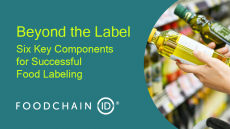Whole Grains Council reveals new weight-based stamp
characteristic stamp in a move to avoid potential regulatory
uncertainty surrounding its use of the terms 'excellent' source or
'good' source. The new stamp will indicate the number of grams of
whole grain ingredients in a serving.
The Whole Grain Stamp program was initiated last year as a way to help consumers keep track of their consumption. The labels currently appear on more than 600 products seen on shelves in the US.
Until now, the black-and-gold stamps have ranked products as 'excellent' or 'good' sources of whole grains according to their content (an excellent source had to have a minimum of 16g per serving). But because the Food and Drug Administration (FDA) remains vague about the use of these terms, the Whole Grains Council (WGC) decided to modify the stamps to preempt potential regulatory changes.
The move is a consequence of the FDA's recent rejection of a petition filed by General Mills requesting the development of definitions for 'excellent source,' 'good source' and 'made with' whole grains.
The agency announced in December that its decision was based on the need to "prevent false and misleading food labeling statements," adding that such terms would lead to consumer confusion on the implied nutrient content of whole grain foods.
"We don't know if the FDA will come to any conclusions about the use of these words. It's a possibility, but we couldn't pin them down on the topic. So instead of waiting around for a reply, we decided to move ahead on our own," said Courtney Davis, media relations manager for Oldways, the WGC's parent company.
The WGC is confident that the new design will make more sense to consumers, and will also educate them about the US Department of Agriculture's daily whole grain intake recommendations.
The new stamps will indicate the whole grain content of products by weight, such as "27g or more per serving" . But because this can still be confusing to some consumers who do not know how this compares to the daily recommended levels, there is also text directly below the stamp reading "Eat 48g or More of Whole Grains Daily".
Last year's Dietary Guidelines included the advice that Americans should consume more than three ounce-equivalents of whole grain products per day, although the precise recommendations vary with age, gender and lifestyle factors. At least half the grains consumed should be whole grains.
In gram terms, this equates to 48g or more of whole grains per day
Indeed, since the publication of new Dietary Guidelines, sales and production of whole grain products have increased steadily. For example, according to the Whole
Grains Council (WGC), sales of whole grain pasta have increased by 20 percent last year, while sales of whole grain bread rose 18 percent.
Standards for products to qualify for the new stamps remain the same as before. Products must contain at least 8g (half a 'Pyramid serving') of whole grains to use the stamp. Stamps on products with at least 16g (a full 'Pyramid serving') of whole grains may also add "100 %" if all the grain in the product is whole grain.
The new graphics will be available this month to members of the WGC. Manufacturers will phase in the new design as they use up existing packaging inventory over the coming months.















